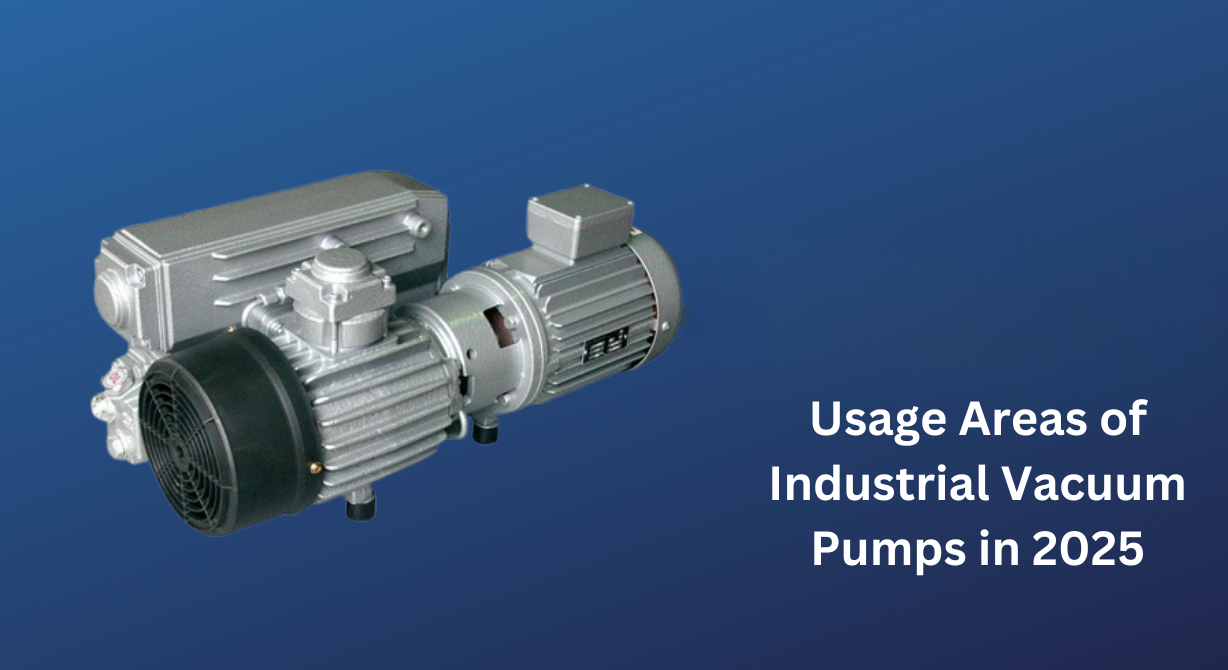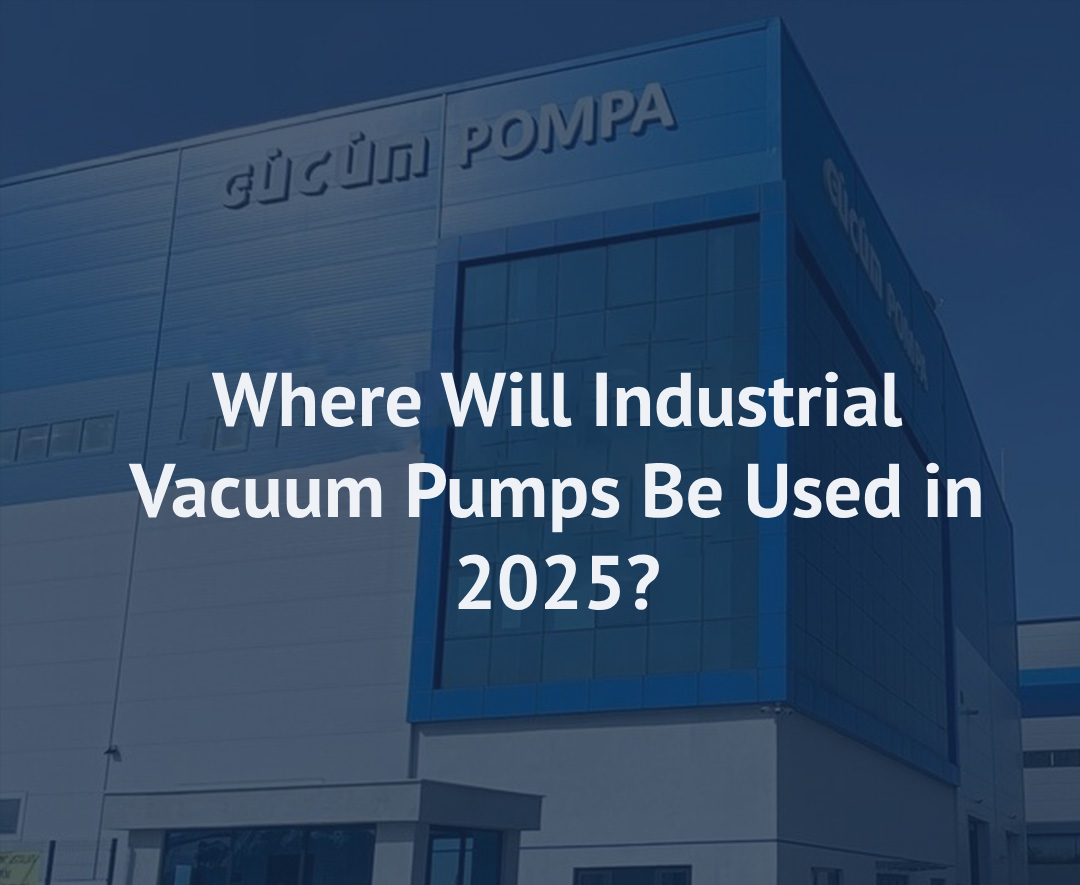Where Will Industrial Vacuum Pumps Be Used in 2025?
Table of Contents
- What Are Industrial Vacuum Pumps?
- Usage Areas of Industrial Vacuum Pumps in 2025
- Food and Beverage Industry
- Chemical and Pharmaceutical Industry
- Electronics and Semiconductor Manufacturing
- Automotive Industry
- Medical and Laboratory Applications
- Energy and Environmental Sector
- Other Industrial Applications
What Are Industrial Vacuum Pumps?
Industrial vacuum pumps are devices that create a vacuum by reducing the pressure of gases or liquids in a system below atmospheric pressure. As of 2025, these pumps are equipped with various technologies, including dry pumps, oil-sealed pumps, screw pumps, and liquid ring pumps, each designed for specific industrial needs. Their primary function is to remove gases, creating a low-pressure environment to enhance process efficiency. For instance, in industries requiring precision, vacuum pumps eliminate contaminants from the environment.
In modern industry, vacuum pumps stand out for their energy efficiency and eco-friendly features. In 2025, pumps equipped with innovative materials and smart control systems require less maintenance and offer long service life. Additionally, these pumps provide customized solutions across industries, helping businesses reduce operational costs.

Usage Areas of Industrial Vacuum Pumps in 2025
With advancing technology, industrial vacuum pumps play a critical role in a wide range of sectors in 2025. Evolving manufacturing techniques and increasing automation expand their applications. Below, the most common sectors utilizing vacuum pumps in 2025 are explored in detail.
Food and Beverage Industry
The food and beverage industry is one of the primary sectors where vacuum pumps are extensively used. In 2025, vacuum packaging technologies are critical for extending product shelf life and ensuring food safety. Vacuum pumps are employed in packaging perishable goods such as dairy products, meat, fish, vegetables, and fruits. Freeze-drying (lyophilization), widely used in producing coffee, fruits, and ready-to-eat foods, relies on vacuum pumps to remove moisture in a controlled manner.
Additionally, in beverage production, vacuum pumps are used for bottling and degassing processes. For example, precise vacuum systems are necessary to control gas levels in carbonated drinks. In 2025, with the rise of sustainable packaging trends, energy-efficient vacuum pump models are increasingly preferred in this sector.
Chemical and Pharmaceutical Industry
In the chemical industry, vacuum pumps are used in essential processes such as distillation, crystallization, drying, and filtration. In 2025, the demand for high-performance vacuum pumps has grown for purifying chemicals and removing hazardous gases. These pumps enable reactors to operate under vacuum, improving the efficiency of chemical reactions.
In the pharmaceutical industry, vacuum pumps are indispensable for sterilization, tablet coating, and active ingredient production. Ultra-clean vacuum environments are required in innovative fields like biotechnology and gene therapy. In 2025, with increased automation in pharmaceutical manufacturing, the integration of vacuum pumps with precise control systems has become more common.
Electronics and Semiconductor Manufacturing
Electronics and semiconductor manufacturing is one of the most precise areas where vacuum pumps are utilized. In 2025, the production of 5G technology, AI chips, quantum computer components, and advanced sensors has heightened the need for high vacuum levels. Vacuum pumps ensure cleanroom conditions by removing contaminants from the production environment.
Processes like vacuum coating (PVD and CVD), plasma processing, and ion implantation are key applications in this sector. Furthermore, global demands for energy efficiency and low-emission production have spurred the development of eco-friendly vacuum pumps.
Automotive Industry
The automotive industry is a dynamic sector where vacuum pumps are widely used in both traditional and innovative applications. As of 2025, these pumps play a multifaceted role in automotive manufacturing, with their importance amplified by the rise of electric vehicles (EVs). In conventional internal combustion engine vehicles, vacuum pumps are primarily used in brake systems. Unlike hydraulic or mechanical brake systems, vacuum-assisted brakes allow drivers to achieve safe braking with minimal effort. These systems are particularly vital in heavy-duty vehicles and high-performance cars.
The proliferation of electric vehicles has redefined the role of vacuum pumps in the automotive industry. Lithium-ion battery production is one of the most significant areas where vacuum pumps are utilized. In battery cell manufacturing, processes like electrode drying and electrolyte filling require a low-pressure environment. Vacuum pumps remove moisture, gases, and contaminants, optimizing battery performance, safety, and lifespan. For instance, operating under vacuum during electrolyte filling eliminates air bubbles within cells, enhancing battery energy efficiency.
Beyond battery production, vacuum pumps find innovative applications in the automotive sector. For example, vacuum molding techniques are used to manufacture lightweight vehicle bodies made from composite materials. Materials like carbon fiber or fiberglass are shaped under vacuum to produce stronger, lighter components, which is critical for improving the range of electric vehicles. Additionally, in surface coating processes for automotive parts—such as corrosion-resistant or decorative coatings—vacuum pumps create clean, controlled environments.
In 2025, the development of autonomous vehicles has opened new avenues for vacuum pumps. Sensors and LIDAR systems used in autonomous vehicles rely on high-precision manufacturing processes. These components are produced in contaminant-free vacuum environments, where vacuum pumps ensure quality and reliability. The production of such advanced electronics underscores the pumps’ role in supporting cutting-edge automotive technologies.
Exhaust emission control remains a traditional application of vacuum pumps in the automotive industry. In 2025, with the rise of hybrid vehicles and low-emission engines, these pumps continue to be used in emission testing systems and degassing processes. In fuel cell vehicle production, vacuum pumps are essential for purifying hydrogen and removing foreign gases from systems. Sustainability trends also influence vacuum pump design in this sector. Energy-efficient and low-carbon-footprint pumps, such as dry vacuum pumps, are preferred for their reduced maintenance and minimal environmental impact compared to oil-sealed pumps. These eco-friendly models align with modern automotive facilities’ goals of reducing operational waste. Ultimately, vacuum pumps address both traditional and forward-looking needs in the automotive industry, delivering quality, efficiency, and sustainable solutions.
Medical and Laboratory Applications
In medical and laboratory settings, vacuum pumps are used for sterilization, aspiration, and precise experimental processes. In 2025, genetic research, biomedical device manufacturing, and innovative healthcare technologies have increased the demand for vacuum pumps. For example, DNA sequencing devices and bioreactors require low-pressure environments.
In hospitals, vacuum pumps are used during surgical procedures and patient care to remove liquids and gases. In laboratories, advanced technologies like mass spectrometry and electron microscopy rely on high vacuum levels. These applications highlight the reliability and precision of vacuum pumps.
Energy and Environmental Sector
In the energy sector, vacuum pumps are used in oil and gas exploration, refining, and renewable energy production. In 2025, they play a significant role in solar panel manufacturing and wind turbine component production. Additionally, vacuum pumps are preferred for degassing and vacuum sealing in hydrogen fuel cell production.
In the environmental sector, vacuum pumps are utilized in wastewater treatment, carbon capture, and recycling systems. For instance, carbon capture technologies require low-pressure environments to extract CO2 from the atmosphere. In 2025, with growing environmental sustainability goals, these applications are rapidly expanding.
Other Industrial Applications
Vacuum pumps are employed in a wide range of other industries. In woodworking, they are used to produce laminated coatings. In plastic molding and composite material production, vacuum pumps eliminate air bubbles from materials. Precision processes like glass coating and optical lens manufacturing also rely on vacuum technologies.
In 2025, the use of vacuum pumps in 3D printing technologies is noteworthy. Vacuum environments are essential for improving material quality in metal and polymer-based 3D printers. In space research, vacuum pumps are used to test satellite components and manufacture rocket engines. These innovative applications demonstrate the versatility of vacuum pumps.


